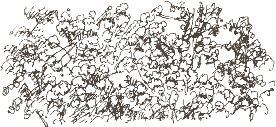
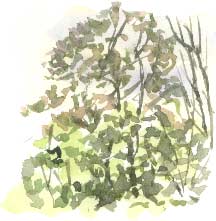 I’M
SURE that one year I’ll have a May when I’ll spend the whole month
out drawing may blossom, wild flowers, butterflies and birds but this won’t
be it. We’re off on holiday next week so we’ve got lots of book
orders to get up to date before we go, not to mention all the effort that goes
into getting veg beds and flower borders planted up at this time of year.
I’M
SURE that one year I’ll have a May when I’ll spend the whole month
out drawing may blossom, wild flowers, butterflies and birds but this won’t
be it. We’re off on holiday next week so we’ve got lots of book
orders to get up to date before we go, not to mention all the effort that goes
into getting veg beds and flower borders planted up at this time of year.
However, here are a couple of drawings of may blossom (hawthorn
blossom) drawn from my mother-in-law’s kitchen.
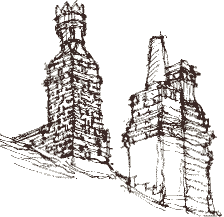
 Chimneys,
Boon's
Chimneys,
Boon's
I’m looking forward to the holiday because, if I feel I’d like
to, I’ll have the leisure to stop and draw. This week one of the rare
chances I get to draw for 15 minutes or so is when I’m waiting in the
barber’s on Queen Street, Horbury; these are the chimney’s
of Boons, which I still think of as the Woolpack.
I prefer the old name but I guess pubs have to reinvent themselves with a spot
of marketing. Although I spend hardly any time in them I’m sorry when
they suddenly get boarded up, like two of the three pubs in South Ossett;
the Crown and the Wash House, formerly the
Queen Victoria (so the change of name didn’t help much
there), or, worse, demolished like the Beehive in Gawthorpe.
They're part of the life of the town.
Horbury is mainly a Victorian village/town but with medieval, Tudor, Stuart
and Georgian buildings still surviving but its centrepiece and - especially
now the Town Hall is just office space - the heart of the community, is the
Georgian St Peter’s Church (right).
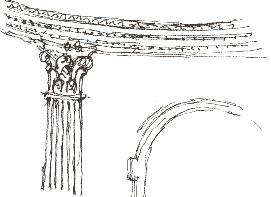
 Celebrating
the Bi-Centenary
Celebrating
the Bi-Centenary
It’s 200 years since the death of Horbury born architect John
Carr (1723-1807) and the church, built at a cost of about
£8,000 (bells and organ a further £2,000) was his gift to his home
town. The ornate gilded columns might seem out of place in the centre of a down-to-earth
town like Horbury but when the church was filled with nearly 300 people, for
the opening talk on a sunny afternoon last weekend the place really comes to
life and works just as Carr intended it should. He was twice Lord Mayor of York
and had an understanding of buildings as settings for social events.
His drawing instruments, in a small case covered in shark's skin, have been
on display with some of his designs this week.
Richard Knowles (right) – of Wakefield
Historical Society, who runs the town’s bookshop - introduced
this evening’s concert.
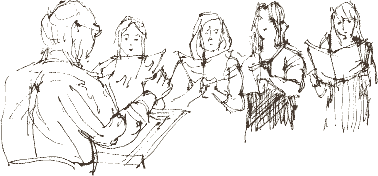
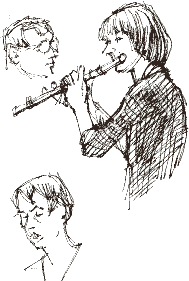 Grace-Notes
Grace-Notes
Sally Dover (right) opened the concert
with short pieces by Bach, Faure and Saint-Saens.
Her final piece in the opening set, Chopin’s Variations
on a Theme of Rossini, is the kind of music you can’t help smiling
to. At the end of it there’s an effect I hadn’t noticed before where
a lively tune has a lower accompaniment to it. If she had been playing in an
orchestra, I’d have assumed that there was a second flute somewhere, playing
the lower notes.
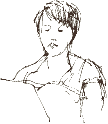 I
expect it’s possible to get the flute to resonate at two frequencies at
once? Grace-notes are the embellishments to a tune played on the bagpipes; perhaps
this was the flautist’s equivalent.
I
expect it’s possible to get the flute to resonate at two frequencies at
once? Grace-notes are the embellishments to a tune played on the bagpipes; perhaps
this was the flautist’s equivalent.
The University of Huddersfield Chamber Choir
sang madrigals from 16th and 17th century, some of which were still performed,
in a domestic setting, in Carr’s day, and rounded the evening off with
some 20th century choral music which worked well in the clear, resonant (but
not slushy) acoustic of the Georgian church. The final piece was London
Town which in fact has a Wakefield connection; the composer
Kenneth
Leighton (1929 – 1988), later a professor of music
in Edinburgh, was born in the city.
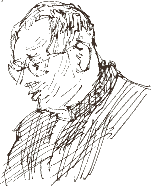
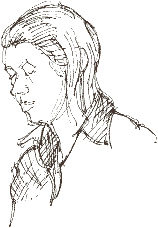 Georgian
Diaries
Georgian
Diaries
The music was interspersed with readings; Katherine Bannister
(right) read from the diaries of Carr’s young nieces, Harriet
and Amelia Clarke who toured Yorkshire with him and attended the opening of
the church in 1794 and Father Peter Twisleton, soon to leave
the parish after 9 years at the church read from the diary of Parson
James Woodforde, the 'most agreeable of diarists'.

 I’M
SURE that one year I’ll have a May when I’ll spend the whole month
out drawing may blossom, wild flowers, butterflies and birds but this won’t
be it. We’re off on holiday next week so we’ve got lots of book
orders to get up to date before we go, not to mention all the effort that goes
into getting veg beds and flower borders planted up at this time of year.
I’M
SURE that one year I’ll have a May when I’ll spend the whole month
out drawing may blossom, wild flowers, butterflies and birds but this won’t
be it. We’re off on holiday next week so we’ve got lots of book
orders to get up to date before we go, not to mention all the effort that goes
into getting veg beds and flower borders planted up at this time of year.
 Chimneys,
Boon's
Chimneys,
Boon's 
 Celebrating
the Bi-Centenary
Celebrating
the Bi-Centenary
 Grace-Notes
Grace-Notes I
expect it’s possible to get the flute to resonate at two frequencies at
once? Grace-notes are the embellishments to a tune played on the bagpipes; perhaps
this was the flautist’s equivalent.
I
expect it’s possible to get the flute to resonate at two frequencies at
once? Grace-notes are the embellishments to a tune played on the bagpipes; perhaps
this was the flautist’s equivalent.
 Georgian
Diaries
Georgian
Diaries